Reports
Yongbyon: A Better Insight into the Status of the 5MWe Reactor
by David Albright and Serena Kelleher-Vergantini
April 29, 2015
ISIS has been regularly monitoring activity at the 5 megawatt (MWe) reactor at Yongbyon, North Korea’s known nuclear complex. In October 2014, ISIS assessed that the 5 MWe reactor was shut down or partially shut down. A more recent assessment using satellite imagery taken in January, February, March, and April 2015 shows that the reactor may be operating at low power or intermittently. Additionally, the winter imagery shows that the centrifuge plant has operated and that North Korea may be preparing for additional renovations at this site.
5 MWe Reactor
In October 2014, ISIS assessed that the 5 MWe reactor at Yongbyon in North Korea, was shut down or partially shut down for either partial refueling or renovations. This assessment derived from the analysis of satellite imagery dated September and October 2014, which showed no steam venting from the turbine building and no visible water being discharged from the secondary cooling system’s discharge pipeline (the most important external signatures related to the operation of the reactor).1 The absence of these two important signatures was also noted in imagery dated December 1, 2014.
Subsequent Airbus and DigitalGlobe high resolution images dated January 19, February 6, March 20, and April 15, 2015 do not show clear evidence that the reactor has resumed full power operation (see figures 1, 2, 3, and 4). However, the presence of snow and ice in the January and February images allow the observation of some additional signatures that suggest that the reactor may be operating at low power or operating intermittently.
This assessment of partial operation derives from the analysis of melting snow patterns on the reactor and turbine buildings. On January 19, 2015, the site was covered in snow and there is very little indication of any melting, which could imply that it either recently snowed or the temperatures were too low for widespread melting (see figure 4). However, on February 6, 2015, the snow had melted in very specific areas at the site. For example, the snow on the roof of the 5MWe reactor had melted in an irregular manner compared to the snow on surrounding roofs (figure 3). This irregular melting could be caused by the combined effect of sun and heat from the inside of the building. In addition, little snow is present on the roof of the reactor’s turbine building, again indicating that the inside of the building could be hot and therefore melting the snow on the roof.
Another important signature visible in the January 19 and February 6, 2015, images is the presence of a weak stream of warm water being discharged from the 5MWe reactor’s discharge pipeline, which was identified when the reactor was operating prior to September 2014. It is important to note that this weak stream of water could have been present also in previous imagery but is only visible now because of the presence of snow and ice. The presence of this water signifies that the 5MWe reactor’s secondary cooling system is active. The secondary cooling system intakes water to cool the carbon dioxide gas heated by the reactor’s operation. However, determining whether it is active for low power operation or simply operating intermittently is not possible from the image. In the March 20 and April 15, 2015 images, an outflow of water is not visible at the discharge point mentioned above. But a weak stream of warm water could be present but not visible without the presence of ice and snow.
Another piece of evidence possibly suggesting operation involves the turbine building which may be emitting steam at the time of the February 6, 2015 image. There is an irregular white shape, consistent with a small batch of steam, visible on the turbine building roof beside the two original vents.
A New Discharge Pipeline?
Because several months have gone by since a clear discharge of water from the 5 MWe reactor was visible, ISIS has been looking for alternative water discharge locations. North Korea may have decided to change the manner or location in which it discharges the water from the 5MWe reactor’s secondary cooling system.
Based on the analysis of recent imagery, two possible discharge locations are noted. The first one can be seen in January and February 2015 winter images and is located slightly down river from the known discharge point on the river band (see figure 1). Its exact purpose, however, is unknown. It is plausible that this pipeline may be connected to the other activities at the reactor site.
The second possible discharge location is on the other side of the reactors and involves two artificial water canals (see figures 1, 5, and 6). Although the precise origin of the water is unknown, the two canals seem to originate from the top half of the reactor site, which is where the 5 MWe reactor is located. The two canals converge and then flow under a road toward what may be a small pump house before ending at the river. A historic analysis shows that the canals were created at the time when light water reactor (LWR) construction started (note that the 5 MWe reactor’s cooling tower had also been destroyed). Also, as figure 6 shows, the water in these canals was not always present. For example, in January 2013 there was water only in one of the two canals while in January and April 2015 water is present in both. The fact that water is visible in winter imagery (with snow and ice) suggests that the water is either flowing or is warm.
Experimental Light Water Reactor (LWR)
The recent imagery does not show any evidence that the LWR has started operation. The secondary cooling system for the LWR is unclear, as is its water discharge location. The absence of a cooling tower implies that the reactor will discharge water into the river once it is operational. However, the precise location of this discharge is unknown. It is possible that North Korea may use one of the canals to the left of the reactors as a discharge location. Alternatively it could simply discharge directly into the river.
New activities at the LWR site include possible earth or oil spills on the road leading toward the back entrance of the reactor and two new small buildings or large containers in the April 15, 2015 image.
Enrichment and Reprocessing Plants
No new external activities have been detected in the immediate vicinity of the gas centrifuge plant located at the fuel fabrication complex in the southern part of the Yongbyon nuclear site. However, as above, the presence of snow in the February 6, 2015 image allows for the observation of one additional signature (see figure 7). The snow on the roof of the main centrifuge building and the two buildings to its left (one of which has a new roof) has melted faster and in an irregular manner compared to the surrounding buildings. This could be due to the effect of the sun (which would be expected to affect more of the buildings at the site) combined with heat being emitted from inside the buildings. It is plausible to assume that North Korea is heating the inside of the centrifuge hall in order to assure the correct functioning of the machines, which are delicate and usually require a stable temperature of about 23° C (75° F). In addition, when looking at the main centrifuge hall, the side that presents less snow on the roof is known previously to have held centrifuge cascades and autoclaves, which are used to heat the uranium hexafluoride into a gas prior to its entry into the cascades. The other half of the building, where the roof remains snow covered, has been constructed in the last few years. The centrifuges and related equipment in this half may not yet be in full operation. Therefore, these signatures suggest that the older portion of the gas centrifuge plant has been operational and the newer part may not be.
Imagery from March 20, 2015 shows eight 8 meter by 1 meter (height unknown) white objects in an open area across the road from the main enrichment building (figure 8). ISIS highlighted the presence of similar-shaped objects once before. In April 2014 similar objects were present in this specific location but where removed by June of the same year. The objects were believed to be construction material. In fact, In June 2014, as soon as these objects were removed, renovations of a roof adjacent to the main centrifuge hall started (see here). As of April 15, 2015, there are 44 of these objects (figure 9). It is possible that North Korea is preparing to renovate new roofs or buildings in the vicinity.
It is also worth noting that a substantial amount of construction has been taking place at a location adjacent to the train tracks that connect the fuel fabrication complex to other locations within the Yongbyon nuclear complex (see figures 8 and 9). A historical analysis of the location showed that as of 2002, two buildings and a stack were present in this area but they were completely demolished between 2003 and 2009. The construction of the new buildings started in early 2010. Prior to 2003, these buildings were believed to have been devoted to supporting activities, according to a former senior UN official close to the IAEA who had frequently visited the site when the Agreed Framework was in effect. The new buildings are significantly different than the demolished ones. In the recent imagery dated March 20 and April 15, 2015, a three story building is visible that is undergoing construction immediately adjacent to a shorter rectangular-shaped one. The taller building has a stack and several possible vents on the roof, while the shorter one seems to have an entrance connected to the train tracks and a large object on the roof, possibly a large vent. There are also foundations for what appear to be three additional buildings. A larger stack is also visible nearby. The presence of stacks suggest the release of harmful gases. There are also new tanks, e.g. behind the new three-story building, that suggest processes using chemicals. However, the precise purpose of these buildings is unknown.
No new activity has been observed at the Radiochemical Laboratory, or reprocessing plant, located south-east of the reactor site.


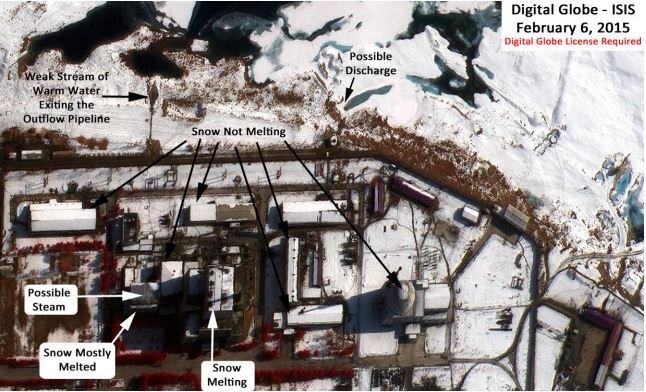
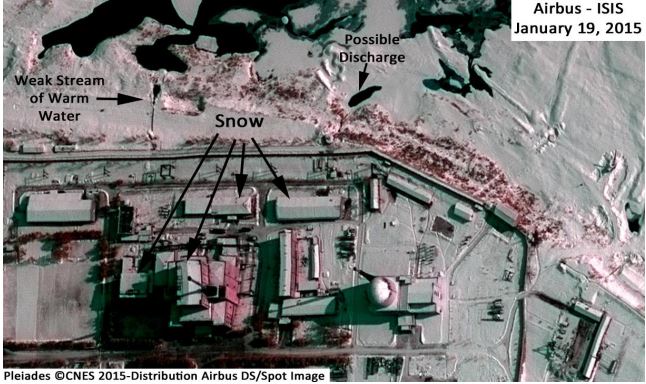

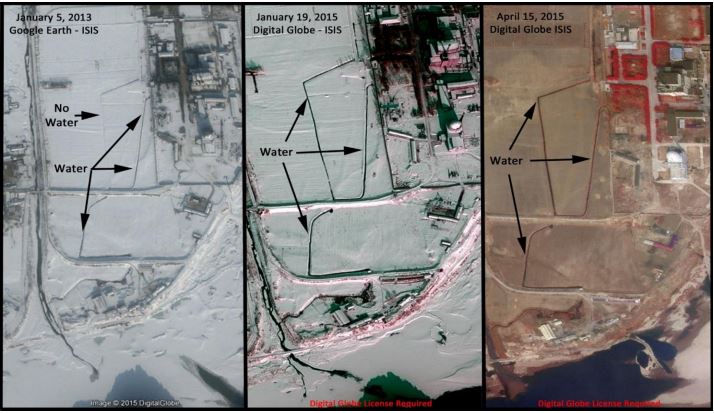
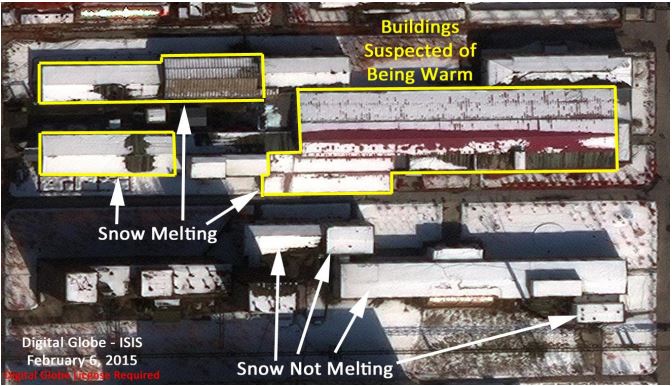
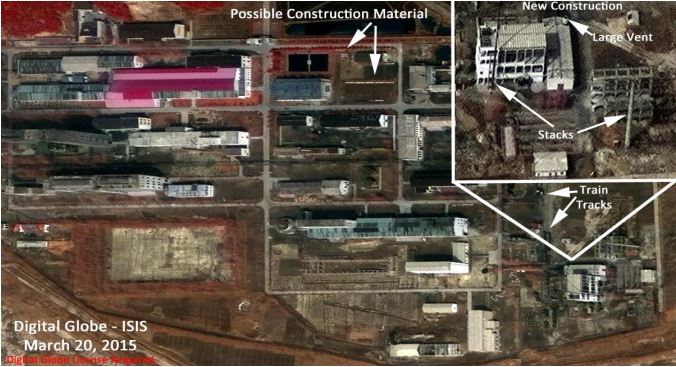
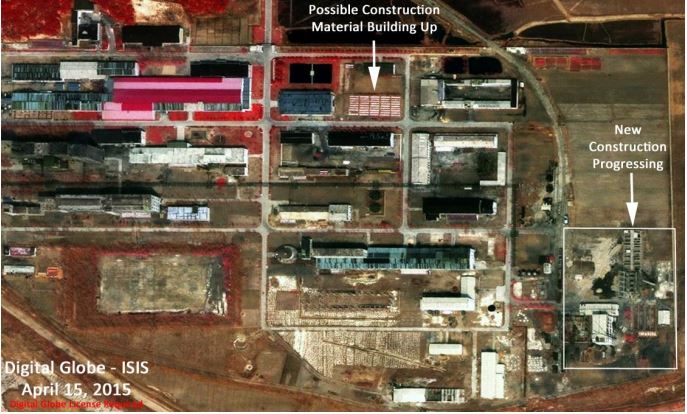
1 See David Albright and Serena Kelleher-Vergantini, “Yongbyon: Centrifuge Enrichment Plant Expands while 5 MWe Reactor is Possibly Shut Down,” ISIS Imagery Brief, October 3, 2014, http://isis-online.org/isisreports/detail/yongbyon-centrifuge-enrichment-plant-expands-while-5-mwe-reactor-is-possibl/10#images

 twitter
twitter